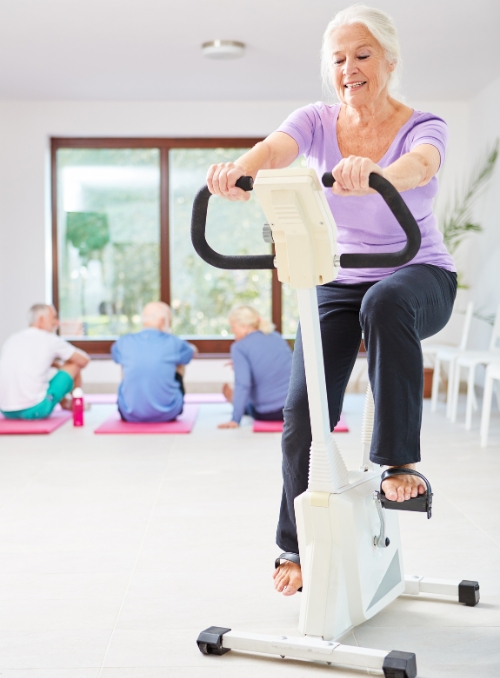Runner’s knee, or Patellofemoral Pain Syndrome, is just what it sounds like—knee pain that stems from the patella (kneecap) to the femur (thigh bone). It’s common among runners—especially competitive ones—and also affects athletes who take part in high-impact activities like running and soccer.
These sports can strain the knee joint, especially if the muscles and tendons around it aren’t strong enough. While sometimes minor, runner’s knee can be a significant reason for stopping running and may even require surgery.
The term “runner’s knee” [1] refers to a condition where the underside of he kneecap rubs against the femur, particularly when running or walking. This friction can cause tenderness, swelling, and pain, sometimes triggered by sudden changes in activity, running too many miles, or being a heavier person.
Other causes include chondromalacia, meniscal tears, or simple overuse. Whether you’re new to running or a seasoned competitor, what you eat and how you move are major factors in preventing knee pain.
Yesterday, I looked at new research on patellofemoral pain syndrome (PFPS).
Today, I’m sharing an effective exercise program for PFPS [2] or runner’s knee—so you can keep training without pain.
Below are runner’s knee stretches and knee strengthening exercises you can start right away. Each exercise in the research program is supervised by a physical therapist, but you can perform them at home.
Tip: Always stop if you feel sharp pain, and keep your injured knee safe by adjusting the range of motion.
1. Warm-Up (5 minutes)

- Hop on a stationary bike or cycle at an easy pace
- Keep your knees bent and move smoothly.
- Maintain feet shoulder-width apart when stepping off.
2. Standing Quad Stretch

- Stand facing a wall or use a chair for balance.
- Bend your right leg, bringing your heel toward your glutes.
- Hold your ankle with your right hand and gently pull.
- Keep your knees together and hips forward.
- Hold for a few seconds, then switch legs.
3. Hamstring Stretch

- Sit in the chair with your left leg extended and your right leg bent, with your foot against your inner thigh.
- Keep the injured leg straight and ankle flexed.
- Lean forward from your hips, right arm reaching down until you feel a stretch in your hamstring muscle.
- Hold for a few seconds, then switch to the other side.
4. Hip Flexor Stretch (Split Stance)

- Start in a split stance with the right foot forward and the left leg back.
- Bend your front knee while keeping your back heel lifted.
- Slowly lean forward until you feel a stretch in the hip flexors.
- Hold for a few seconds, then switch sides.
5. Wall Slide (Strengthening)

- Stand with feet shoulder-width apart and your back against a wall, and arms overhead.
- Slowly lower into a squat, knees bent, elbows bent on the side, keeping the knees aligned over the toes.
- Hold for a moment, then slowly lift back to standing.
6. Straight Leg Raise

- Lie on your back with one leg bent and foot flat on the floor, the other leg straight.
- Tighten your thigh muscles and lift the straight leg to the height of your bent knee.
- Hold briefly, then lower slowly.
- Repeat and switch legs.
According to Dr. Jordan Metzl, MD, a sports medicine physician at the Hospital for Special Surgery in New York, “For runner’s knee, strengthening the quadriceps, glutes, and hip stabilizers is essential. Many runners focus only on mileage and speed, but targeted knee strengthening exercises help control how the kneecap tracks during running. This reduces stress on the knee joint and lowers the risk of flare-ups—especially for those logging too many miles or returning from injury.”
Why This Works
A 6-week supervised exercise program like this one improves strength, flexibility, and knee stability. Research shows participants experienced less pain both at rest and during activity, along with better overall knee function, compared to those who only rested.
Progress comes from combining:
- Cardiovascular work (warm-up)
- Leg strengthening (wall slides, straight leg raises)
- Flexibility (hamstring, quad, hip flexor stretches)
- Balance training (maintaining control through movements)
Final Takeaway
Having a physical therapist or coach guide your runner’s knee [3] rehab ensures you’re progressing safely. Focus on consistent practice, protect your injured knee, and adjust exercises to avoid causing pain.
With patience, runner’s knee stretches and strengthening exercises can help you get back on the track pain-free.
I have found one program on runners’ knee, or patellofemoral pain syndrome, which I like and think will help you. Check out this Patellofemoral Syndrome Solution now!
FAQs
What is runner’s knee, and how is it different from other knee injuries?
Runner’s knee—also called patellofemoral pain syndrome—is pain around or behind the kneecap, often caused by overuse, muscle imbalance, or improper tracking of the kneecap. Unlike ligament tears or meniscus injuries, it’s usually not a structural tear but a tracking and alignment issue.
Can I still run if I have runner’s knee?
It depends on the pain level. Mild discomfort may improve with modified training, low-impact cross-training, and proper stretching. If running causes pain beyond mild soreness, rest and focus on treatment options like physical therapy first.
How long does it take to recover from runner’s knee?
Recovery can take a few weeks to several months, depending on severity, consistency with rehab exercises, and whether aggravating activities are avoided.
What are the best runner’s knee stretches?
Runners knee stretches include the standing quad stretch, hamstring stretch, hip flexor stretch, and iliotibial band stretches. All should be done gently, holding each for 20–30 seconds, without forcing the injured knee.
When should I see a doctor or physical therapist?
If pain persists for more than 2–3 weeks despite rest and exercises, worsens during daily activities, or is accompanied by swelling or instability, consult a physical therapist or sports medicine doctor for assessment.


